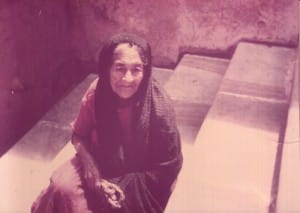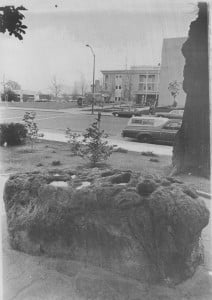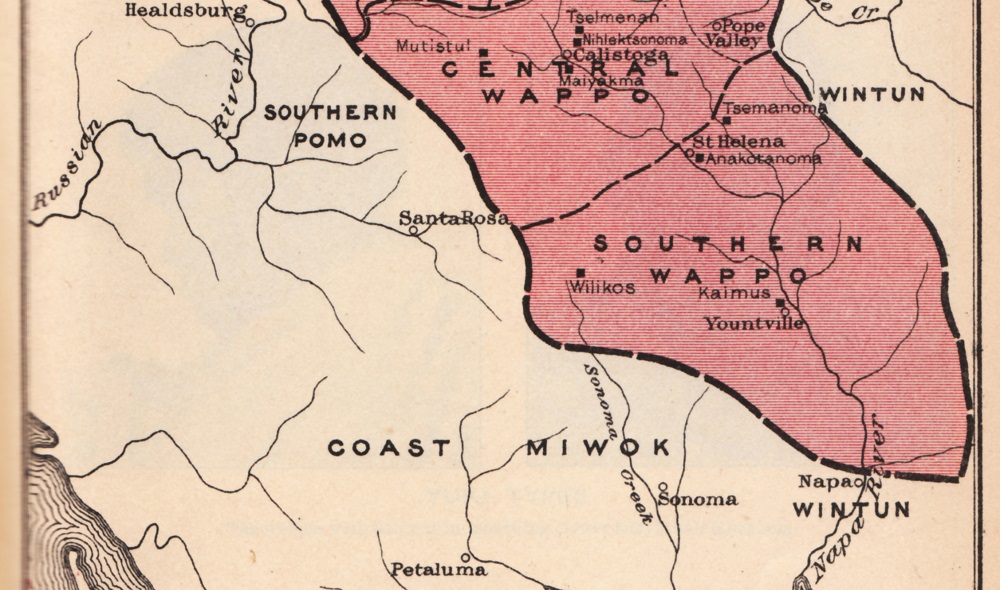Native American History
Napa’s First People
The first settlers came to Napa County about 10,000-12,000 years ago. The Southern Patwin, so-called for their word pat-win, meaning “people,” were a southern branch of the Wintun (or Wintu) that occupied most of the land around Suisun, Vacaville, and Putah Creek.[1] Named for the Americanized version of the Spanish word guapo in reference to their brave resistance against the Mexican conquest, the Wappo lived throughout the Sonoma and Napa Valleys.[2]
 The Wappo spoke a unique dialect of the Yukian language, a group they split off from about 500 or so years prior to white contact. Like the Patwin, the Wappo were hunter-gatherers, consuming local seafood, deer, rabbit, fowl, acorns, and roots. They were famed for their basketmaking. “Wappo villages were led by a chief, male or female, who was chosen for life. The villages were usually located along creeks, and were composed of oval grass-thatched houses…[They] were generally very peaceful, except for occasional warfare with the Pomo and struggles against Spanish incursions in the Napa Valley.”[3]
The Wappo spoke a unique dialect of the Yukian language, a group they split off from about 500 or so years prior to white contact. Like the Patwin, the Wappo were hunter-gatherers, consuming local seafood, deer, rabbit, fowl, acorns, and roots. They were famed for their basketmaking. “Wappo villages were led by a chief, male or female, who was chosen for life. The villages were usually located along creeks, and were composed of oval grass-thatched houses…[They] were generally very peaceful, except for occasional warfare with the Pomo and struggles against Spanish incursions in the Napa Valley.”[3]
The Patwin spoke a dialect of the Penutian language family. Like the Wappo, Patwin men generally wore no clothing and women typically an apron or skirt of shredded bark, tule, or animal skin. “There were numerous Patwin tribelets, consisting usually of a village with several satellite villages…dwellings, sweathouses and dance houses were all semi-subterranean, earth-covered structures.”[4]
Many places in Napa County derive their names from Native American words. Suskol and Tulukai were Patwin villages near the Napa River. Suskol became Soscol, and Cayetano Juarez named his rancho Tulucay which Americanos later converted to “Tulocay.” The Wappo villages of Kaimus became George Yount’s Rancho Caymus and the Maiya’kma became Serro de los Mallacomes or the Mayacamas Mountains on the western side of the county. Even the word “Napa” may have come from the Napatos Patwin village. Dr. Edward Bale, who owned Rancho Carne Humana in the upper valley, may have given his land grant that name as a pun on his profession because it translates to “Ranch of Human Flesh.” However, there are two other possible origin theories: it might have referred to the erroneous belief that the local Wappo were cannibals; or it might have been a failed attempt by Bale to write down the pronunciation of the name of the nearby Wappo settlement Colijomanoc or Callajomanas.
Anthropologist Alfred L. Kroeber estimated that prior to the incursion of white settlers there may have been nearly 1,000 Wappo in the Napa Valley and more than 12,000 Wintu state-wide. By 1843 there were fewer than 3,000 Wappo and Patwin combined in Napa County, though in 1851 there were nearly 8,000 Wappo throughout Northern California. By the 1970s it was believed that there were only about 50 Wappo left in California.[5] Kroeber reported that there were 22-150 Patwin left in California in 1924, although none were believed to be Southern Patwin; it is unknown how many Southern Patwin are around today.[6] Today the Mishewal Wappo Tribe of Alexander Valley has over 300 members and is the last extant band of Wappo in the area. Most of the 2,500 Wintun now live on rancherias in the North Central Valley.
 If you have the opportunity, stop by the old county courthouse in Napa to see the Wappo Grinding Stone at the corner of Third and Brown. Wappo traditionally used portable mortars and pestles for grinding acorns and other foodstuff. That this grinding stone is so massive and has so many holes makes it very unusual. The amount and depth of the holes indicate it was likely in use for at least 1,000 years. Perhaps it or its original location in the Dry Creek area held some ceremonial or cultural significance? The stone was relocated to its current site in the 1940s and is now behind a chain link fence as the building undergoes earthquake repairs.
If you have the opportunity, stop by the old county courthouse in Napa to see the Wappo Grinding Stone at the corner of Third and Brown. Wappo traditionally used portable mortars and pestles for grinding acorns and other foodstuff. That this grinding stone is so massive and has so many holes makes it very unusual. The amount and depth of the holes indicate it was likely in use for at least 1,000 years. Perhaps it or its original location in the Dry Creek area held some ceremonial or cultural significance? The stone was relocated to its current site in the 1940s and is now behind a chain link fence as the building undergoes earthquake repairs.
Napa County was also home to the Lake Miwok in the Pope Valley and Clear Lake areas. The Pomo in the north and western areas of the present county borders, the Coast Miwok in the south, and the Patwin in the east and north surrounded the Wappo, making the region very culturally diverse.
[1] Patti J. Johnson, “Patwin,” in Handbook of North American Indians vol 8, ed. Robert F. Heizer (Washington D.C.: Smithsonian Institution, 1978).
[2] Robert F. Heizer, ed., “The Archaeology of the Napa Region,” Anthropological Records 12, no. 6 (Berkeley: University of California Press, 1953).
[3] B. A. Leitch, A Concise Dictionary of Indian Tribes of North America 1st ed., (Algonac, MI: Reference Publications, Inc., 1979).
[4] W. C. McKern, Functional Families of the Patwin, (Berkeley: University of California Press, 1922).
[5] Alfred L. Kroeber, Handbook of the Indians of California, (Washington D. C.: Government Printing Office, 1925).; Leitch, 1979.
[6] Kroeber, 1925.


